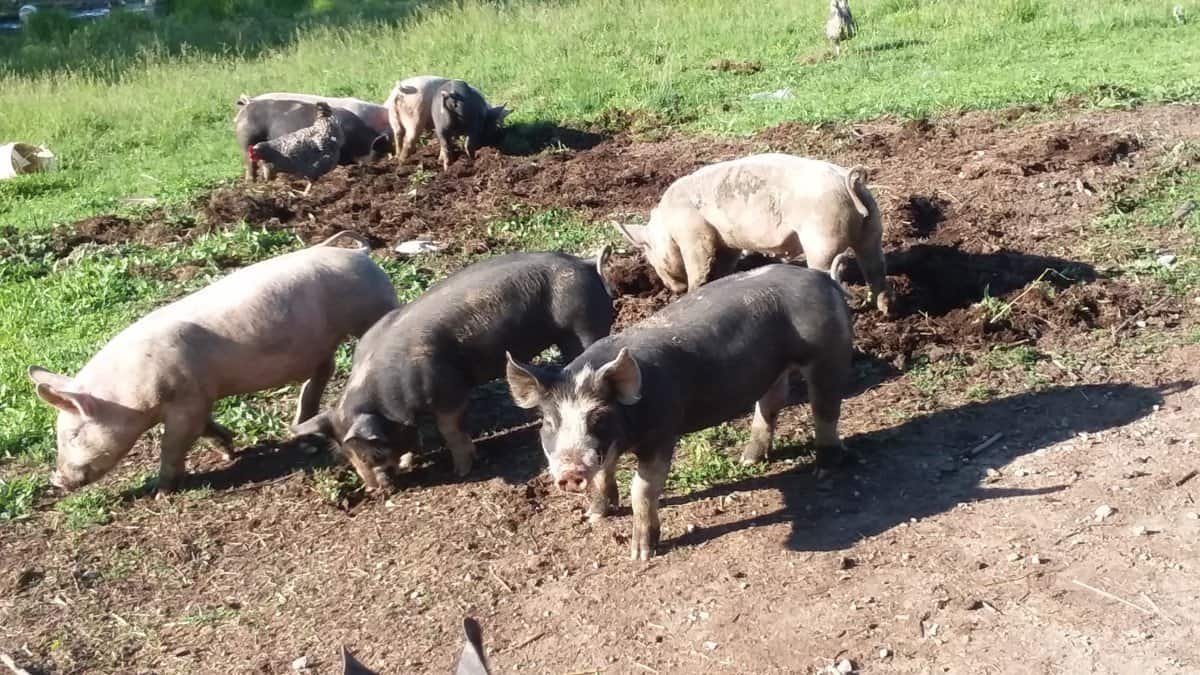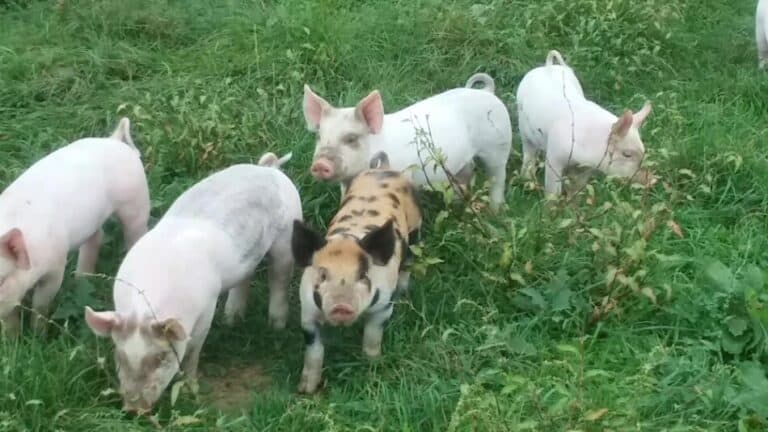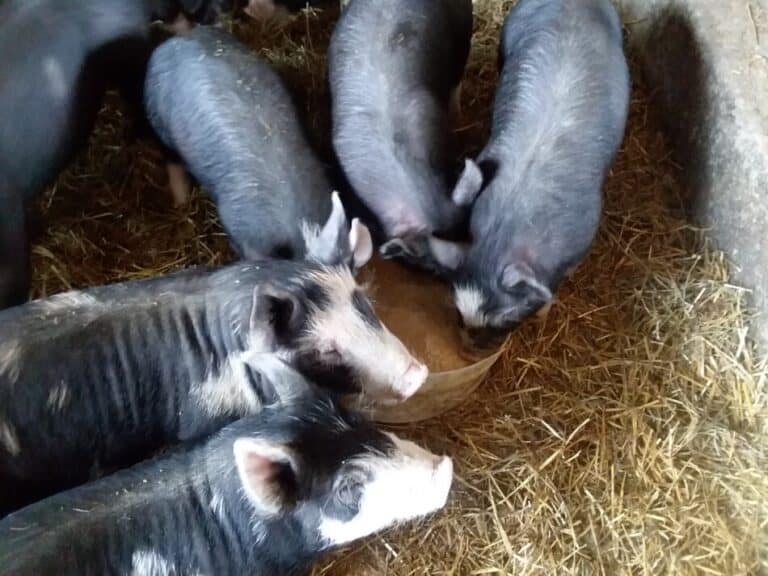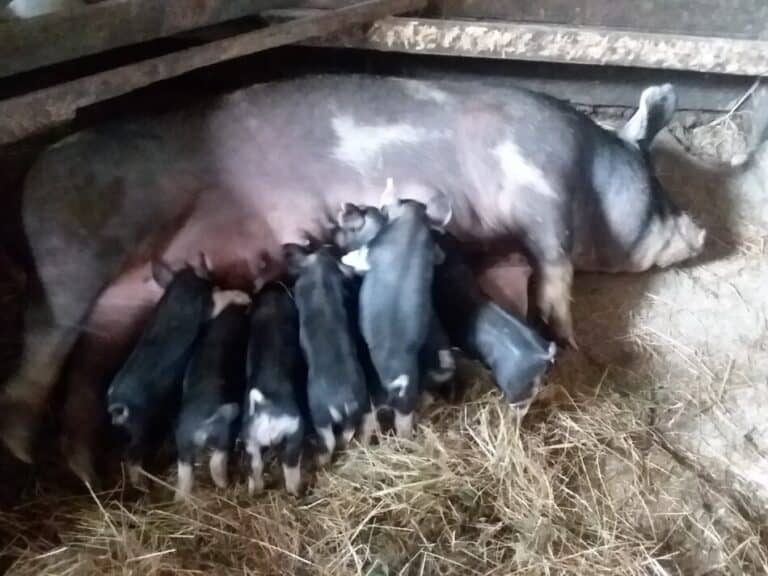How Fast Do Pigs Grow? 5 Keys For Success
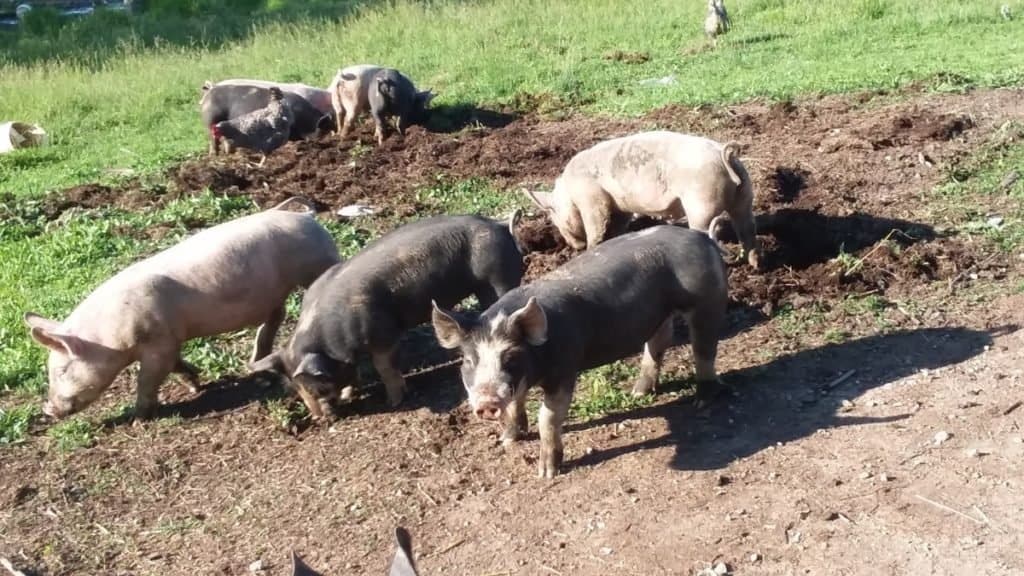
Interested in getting and raising some feeder pigs? Maybe you’d like a bit more clarity on what you are getting into here?
There are some things you can influence (and some things you can’t do anything about) that determine how quickly your pigs get to market weight. You’ll want to know about both.
Pigs will grow from a birth weight of four pounds to a finishing weight of 250 pounds in five and a half months. Growing pigs to 280-300 pounds will take another month. Using unusual or rare breed genetics, hot weather, having pigs on pasture or in wooded areas or limiting grain will also increase the time it takes to grow out the pig.
| When You Buy feeder pigs | Weight of feeder pigs | Grown to 250 pounds | Grown to 300 pounds |
| April 1st | 35 pounds each | September 1st | October 1st |
| April 1st | 60 pounds each | August 1st | September 1st |
| May 1st | 35 pounds each | October 1st | November 1st |
| May 1st | 60 pounds each | September 1st | October 1st |
| June 1st | 35 pounds each | November 1st | December 1st |
| June 1st | 60 pounds each | October 1st | November 1st |
| July 1st | 35 pounds each | December 1st | January 1st |
| July 1st | 60 pounds each | November 1st | December 1st |
I enjoy having a few pigs around. They are fun and full of character! It always amazes me how fast that little feeder pig I just bought (or just weaned off their mom) can grow.
Is Raising Pigs For Meat Worth It? will walk you through the costs involved in getting your porkers raised and into the freezer.
But, I have to admit, some seasons of the year are better for me to have pigs than others. Like having a pen of just about full grown market hogs when the sub zero temperatures hit.
We don’t have heated waterers-that’s just me and the bucket.
For pigs that big, that’s a lot of bucketing. Planning to have the pigs sold by the time it gets more difficult to take care of them is my preferred plan, for sure!
To get all this figured out, we need an idea of how fast pigs will grow so we can plan according to the seasons.
Another biggie as far as planning goes is getting your butchering appointment set up. You’ll need to do a bit of figuring to be sure your pigs are ready when you need them to be!
Here’s an article on How To Tell When You Pig Is Ready To Butcher, if you want more specifics.
How fast do pigs grow?
Feeder pigs (young weaned pigs) will grow from 60 pounds to 250 pounds in five and a half months. Here is the breakdown of the growth stages:
- Your pig will start out at about four pounds when it is born. It will stay with it’s mom until it and all of it’s litter mates are weaned, which is generally around 8 weeks of age.
- Most people would purchase a feeder pig which is a young piglet that is completely capable of eating all of the food it needs and no longer needs to stay with it’s mom. This feeder pig will be between 50-60 pounds and be 10-12 weeks old.
- Your feeder pigs will stay with you until they are full grown, which is generally 250 pounds. Some people prefer a leaner pig which would be more around 230 pounds, so this person’s pigs would be ready to butcher sooner, closer to the five month mark. Other pig raisers like a pig to have more fat, so they raise their pigs to more like 280-300 pounds. (We like 300 pounders, but the extra weight does take extra time for the pig to grow.)
You could get a smaller pig, I got four that were 25 pounds each a few years ago, when the price for 50-60 pounders was more than I was willing to spend at the time.
A smaller pig will need more time to grow and is less hardy than a bigger feeder pig.
My four small pigs ended up just fine but they seemingly took forever to grow to full size.
I don’t really think they actually took tons longer to grow, it just seemed like it! I’d say I had them for an extra month, at least.
Here’s the data on our market hogs, how long they took to finish and how much feed it took to get them there in this article.
Pigs weighing 300+ pounds will take 6-6.5 months on full feed
A good guess for getting your pigs to a higher weight, more along the lines of 300+ pounds, you’ll need to allow for another month or so, taking the total time to 6-6.5 months.
This is for pigs on full feed, other rations will take longer.
5 Factors that determine growth of your pigs
Your pigs have the ability to grow to their genetic potential when you get them, if they have been well cared for up til now.
How you take care of them from here on determines how fast they will grow.
I should also mention these five factors are not in order of importance!
All five things are all needed. Neglecting one of them, any one of them, will cause you problems.
These are all pretty basic and easily managed, but still all critical to success.
For more specifics on raising feeder pigs click on When To Get A Feeder Pig, which is an article I wrote that gives estimates on feed and other expenses.
Genetics dictate the growth potential of your pigs
As long as you start out with good healthy feeder pigs your pig raising adventure should be a success.
Keep in mind that the feeder pigs can only grow to their genetic potential and that will only happen if you do your part to make sure they have a happy life and plenty of feed and water.
Each breed of pig will grow a bit differently than another. This is no surprise but is worth remembering.
Everyone seems to have a favorite breed that gives them the most traits they like and the least traits they do not like, but as will all animals no breed is perfect for everyone, every where.
Best Breed Of Pig For Homesteaders will go over the common pig breeds you are likely to come across and help you find the ones that will work best for you.
The most common option is the crossbred feeder pig. These are the mostly white pigs with grey specks/spots on their back by the tail.
This is referred to as a “blue butt.” The blue butt is a cross using a white mom like a Yorkshire or a Landrace and a colored breed dad like a Hampshire or Berkshire.
This cross gives you a fast growing meaty pig. Since it is a cross between two (or more) breeds, it also has what is called “hybrid vigor”.
Hybrid vigor means that a cross between different breeds or breeding lines of pigs gives a stronger, faster growing feeder pig as a result.
I know that if you do any reading you’ll see that heritage breeds are the hot thing, and I love them as well.
But consider using a commercial cross feeder for your first project, just to get the bugs worked out.
If you want to learn more about heritage pigs consider my article What Is Heritage Pork? which discusses breeds and systems in which the pigs are raised.
Commercial cross feeder pigs will be just as hardy, likely to grow a bit faster and probably significantly less expensive just because they are more commonly available.
If you feel that only a purebred is right for you, then go for it of course! Just realize you will pay more for the pigs and they will take a bit longer to finish.
Environment for the pigs matters for health
Where and when you choose to keep your pigs will influence the happiness of the pigs, which will influence their growth.
Pigs are successfully raised year round in many parts of the country.
How To Naturally Raise Happy, Healthy Pigs goes over the key points to remember to keep both you and your pigs happy!
Your pigs need to stay in an area that is comfortable, even when the weather gets extreme, really cold or really hot.
Some of these weather extremes can be avoided by choosing to raise your pigs at a different time of year so they will most likely be happier, like spring or fall.
Pigs can be raised outdoors or completely inside depending upon your situation and what you want them to do for you.
What? What can pigs do for me?
Well, as you know pigs like to root around and will look for things to do to keep busy, so make sure they have options of things to work on during the day.
We like to have the pigs root around in the bedding from the sheep kept inside over the winter. This aerates the bedding pack and makes it easier to haul out.
Your pigs can also go out on a pasture or section of your yard. Be aware that they will root it up!
Pigs do like to be outside and love to snack of grass, roots and bugs.
They will need a shelter, so they can get out of the wind and rain but mainly to shade them from the sun.
High quality feed is needed for best growth
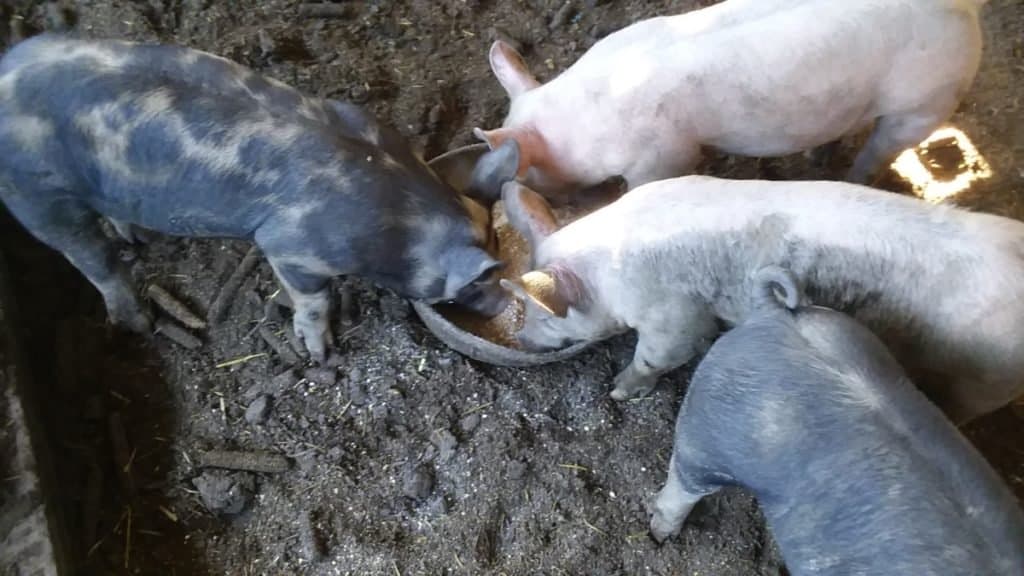
The quality of the feed for your feeder pigs will be a huge factor in determining results.
Your pigs must have plentiful, high quality feed available at all times to grow as much as you are hoping for.
Best Feed For Pigs give you common options to feed your porkers and the pros and cons that go with those options.
Pigs are amazing in their ability to adjust to eating nearly anything, and they do like to experiment with different snacks.
However the best growth will come form a pig getting all of the feed it wants.
Of course you can give it things to make life more interesting, like pasture or kitchen scraps, as long as the most calories come from feed. If you have some hay, toss a flake in every day, pigs enjoy it.
Feeder pigs need to eat more than just grass, it is the way their stomach and digestive system are designed to work, to grow quickly and finish in the time frame you are hoping for.
As far as digestion goes, pigs eat a diet more like ours and less like other farm animals like sheep or cattle, which are ruminants and can live on grass.
That being said there is at least one farm raising pigs without grain that I am aware of Sugar Mountain Farm of Vermont.
They do supplement the pigs when they can with dairy (that is locally available) as well as pumpkins, sunflowers, etc. and have stock that has been genetically selected for eating mostly forage.
Stress: low stress equals happy pigs
Happy pigs will grow faster and will be healthier. Happy pigs have a low stress life.
How do you keep stress low for your pigs?
By making sure they have plentiful food and water and an engaging and comfortable environment in which to live.
Pigs are looking for a way to stay busy and it actually stresses them to have nothing to do all day.
This is the reason why confinement hogs start to do crazy things like bite each other’s tails, they need something to do.
Give them an outlet for their energy like bedding to rustle through or some ground to root up, it will make them happier and reduce their stress.
Not all pigs get along, especially if you are combining groups.
Try to keep the pigs in multiples of 3, to reduce fighting.
For some reason pigs grow better when the group they are in has a total number that is evenly divided by three.
In a group that does not divide evenly by three, four for instance, it is more likely the fourth pig will get picked on by the others.
Reducing Stress in Show Pigs explains some of the stresses that can negatively affect pigs. Don’t get thrown off by the show pig part, most of the things listed are applicable to anyone raising pigs!
Water should be available always
Pigs need plenty of water, especially in the heat.
At least around here, in the height of summer it gets hot enough that the pigs will stop eating during the day and wait until cooler temperatures at night to eat their feed.
Even though they are not eating during the heat, they still need water. And as they grow so does their need for water.
If you are using buckets to water your feeder pigs, you’ll definitely notice this quickly!
A word to the wise: pigs are expert water spillers.
Sometimes on purpose sometimes just because the pan is in the way and they want something underneath or they just want to roll around in it.
Either way now the water is on the ground. Keeping pigs supplied with water can be a challenge!
Keep in mind that if the pigs don’t have water left over in their pan or waterer when you check them the next time then you need to find a way to get them more water for the day.
Your pigs should not be running out of water.
This is especially critical in the heat, they will go through tons more water when they, and you, are feeling hot and sticky.
A trough that is short enough for a pig to drink out of is also short enough for them to jump into or try to jump into and spill.
A 55 gallon barrel that is kept full with a water cup in the bottom works well, they will tip it if you let it get more than half empty though.
All the weight of the water makes it too much for them to tumble over, unless they are really determined then anything is possible!
